
table of contents
- Edible species of aloe
- A. arborescens
- A. ferox
- A. vera
- Poisonous aloe species
- A. africana
- A. aristata
- A. brevifolia
- A. polyphylla
- A. striata
- A. variegata
- A. aculeata
- A. broomii
- A. chabaudii
- A. cryptopoda
- A. grandidentata
- A. humilis
- A. koenenii
- A. lineata
- A. peglerae
- A. saponaria (A. maculata)
They are known for their imposing leaf rosettes. There are nearly 500 different types of these succulents. These include both edible and poisonous varieties. The most well-known representative among the countless varieties is undisputedly the edible aloe vera. In order to recognize and differentiate the plants correctly, we have listed some well-known and less well-known Aloe species as small guides.
Edible species of aloe
Note: Unpeeled leaves of the aloes are not edible. They contain high levels of anthranoids, which are poisonous. Likewise, gel from the leaves should not necessarily be prepared by yourself. Even with the most careful separation of the leaf shell, aloin can get into the gel. This ingredient is also toxic.
A. arborescens
 This is a tree aloe from South Africa. In this country her name is wound cactus or eternal aloe. This species is less well known, but it grows very quickly. The woody trunk is bare and can be up to 3 meters high. Usually there are several tribes. A loose rosette of leaves appears at the end, consisting of narrow leaves that are serrated on the edge. After one to two years, many side shoots form at the base of the trunk. These plants can safely tolerate a few minus degrees. A cut back is also possible. They then drive out again without any problems.
This is a tree aloe from South Africa. In this country her name is wound cactus or eternal aloe. This species is less well known, but it grows very quickly. The woody trunk is bare and can be up to 3 meters high. Usually there are several tribes. A loose rosette of leaves appears at the end, consisting of narrow leaves that are serrated on the edge. After one to two years, many side shoots form at the base of the trunk. These plants can safely tolerate a few minus degrees. A cut back is also possible. They then drive out again without any problems.
- bush-like growth
- 60 to 80 cm long inflorescence
- Bright red to scarlet flower color
A. arborescens is not only edible, but also approved as a medicinal plant. The juice from the leaves can heal burn wounds.
A. ferox

This tree aloe is also known under the name Kapaloe or Wild Aloe. It has its origin in the arid regions of South Africa. The trunk can easily reach a height of 3 meters. It is covered with dull green, slightly reddish tinged leaves. They are thick-fleshed and have brown, hard thorns on the edges. The top and bottom of the leaves have horny spines. The leaf length varies between 80 and 100 centimeters.
- Flower clusters up to 130 cm high
- branched inflorescences
- Bright scarlet to orange flower color
The thickened juice of the leaves is used as a remedy.
A. vera
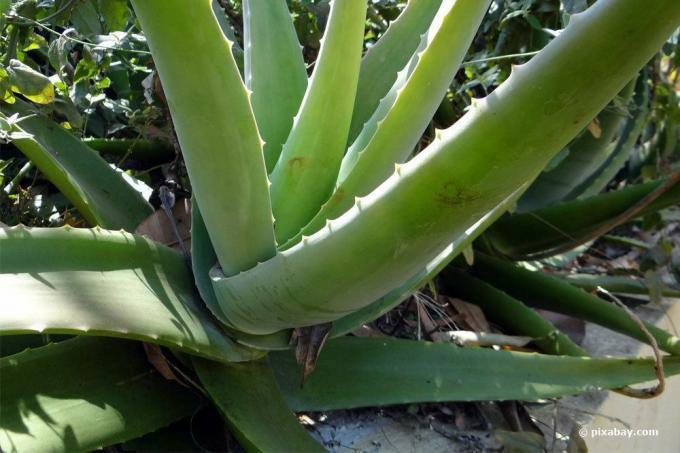 Sometimes it can also be called A. barbadensis are traded. In this country it is known as desert lily or real aloe. It originally comes from the Arabian Peninsula. This type of aloe is probably the best known. The trunk is 35 to 55 centimeters high and has elongated to lanceolate leaves. These can reach a length of 50 centimeters and are blue-green in color with white spots. Pink-red to red teeth are arranged on the leaf margins. Side shoots and runners can form at the base of the plant.
Sometimes it can also be called A. barbadensis are traded. In this country it is known as desert lily or real aloe. It originally comes from the Arabian Peninsula. This type of aloe is probably the best known. The trunk is 35 to 55 centimeters high and has elongated to lanceolate leaves. These can reach a length of 50 centimeters and are blue-green in color with white spots. Pink-red to red teeth are arranged on the leaf margins. Side shoots and runners can form at the base of the plant.
- 60 cm high flower stem
- tubular flowers
- Flower color yellow to orange
- Flowering April to August
The gel inside the leaf is particularly suitable for consumption. It is found in various industrially manufactured foods such as yogurt.
The plants are also known for their medicinal properties. The ingredients of the plants are also used in the cosmetics industry, for example in body lotion and creams. They are also used in everyday objects such as panty liners or cotton swabs.
Care instructions for this plant You will find here.
Poisonous aloe species
The majority of the aloe species are not suitable for consumption because of their toxicity.
A. africana

As the name suggests, this representative comes from Africa. Its very spreading leaves, which are arranged in a rosette, are particularly noticeable. The leaf surface is bare, underneath there are reddish thorns and the tip of the leaf is also covered with red thorns. The trunk is upright and can reach a height of 4 meters.
- branched growth
- candle-like inflorescences
- densely occupied
- Flower color bright yellow to orange
A. aristata
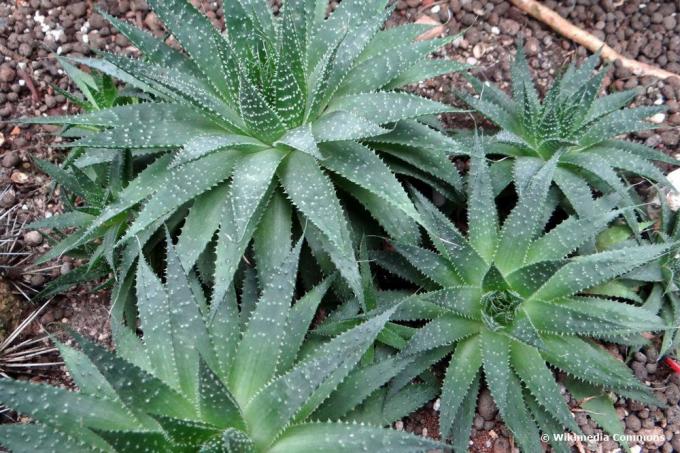 This species is native to South Africa and grows without a trunk. The leaves stand together in a rosette. They are fleshy dark green to gray in color and are 8 to 15 centimeters long. There are whitish spines on their edges. The leaf surfaces are covered with white warts. Numerous side shoots can form with age.
This species is native to South Africa and grows without a trunk. The leaves stand together in a rosette. They are fleshy dark green to gray in color and are 8 to 15 centimeters long. There are whitish spines on their edges. The leaf surfaces are covered with white warts. Numerous side shoots can form with age.
- 50 cm high inflorescence
- Flowering in May
- orange flowers
- only last a few days
A. brevifolia
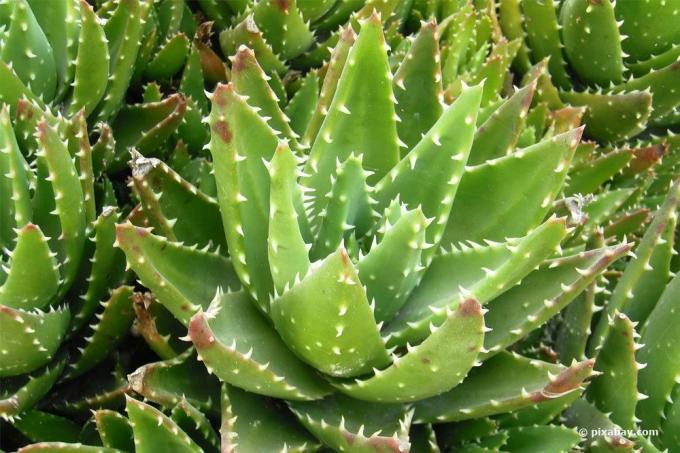 The light green leaves are 8 to 12 cm long. Its edge is covered with dense spines. With increasing age, the trunk tilts sideways. Side shoots can develop in the leaf axils.
The light green leaves are 8 to 12 cm long. Its edge is covered with dense spines. With increasing age, the trunk tilts sideways. Side shoots can develop in the leaf axils.
- Inflorescences 30 cm long
- The flower color is deep red
A. polyphylla

This Spiraloe does not form a stem. As the name suggests, the leaves are arranged in a spiral. They are somewhat egg-shaped to elongated and tapering to a point at their ends. They are arranged in five spiral rows. The leaves are green with a purple tip. It is one of the few species that can survive a few freezing temperatures over a short period of time.
- densely branched inflorescence
- Height 50 to 60 cm
- Flower color light red to deep salmon red
A. striata
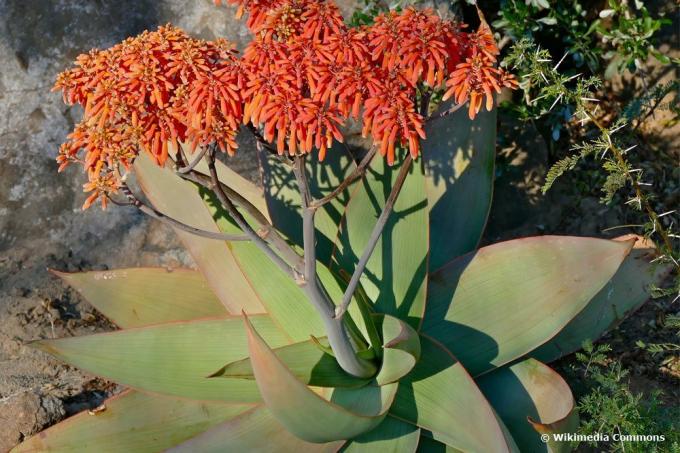
It is a stem-forming Aloe species. This consists of several parts. There are sometimes up to five shoots. They can very often be covered with dead leaves. Otherwise the leaves are beautifully colored light green.
- Flowers appear in summer
- Buds inconspicuous
- Coral red flower color
- hence the name "Coral Aloe"
A. variegata
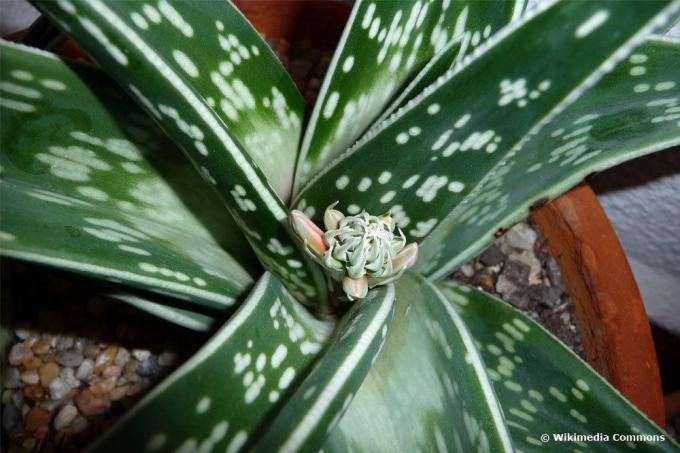
This is a dwarf form of the aloes. It reaches a height of 40 cm. However, it must be said that it can reach a height of 4 meters in its home. The 10 to 15 cm long and lanceolate, fleshy leaves are arranged around the trunk like roof tiles. At first they stand upright and as they get older they tend to curl up. The leaf color is green with irregular, white transverse bands. The first flowers appear with a plant size of 10 to 15 cm. The stem can easily tip over if there are numerous flowers.
- 30 cm high flower stem
- Flowering April to May
- Flower color pale pink to scarlet red
A. aculeata

These plants differ from others of their kind in that they have no trunk. They are rather creeping and growing with a length of up to 70 centimeters. The large rosette of leaves with thick, thorny leaves is very striking. They are up to 60 centimeters long and approximately 12 centimeters wide.
- up to 100 cm high inflorescence
- Bright lemon yellow flower color
A. broomii
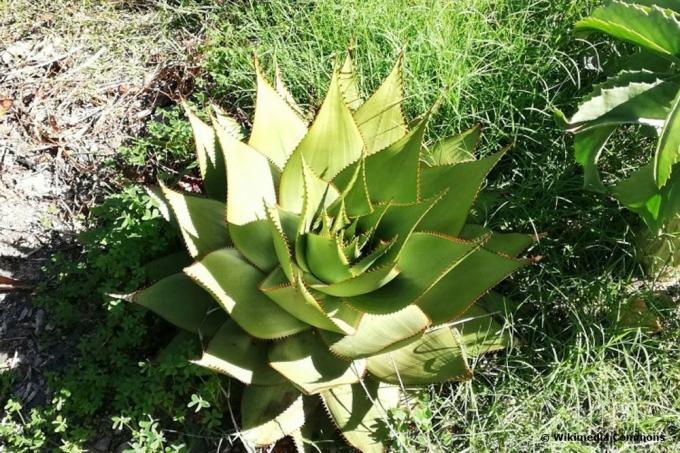
These representatives of the plant genus originally come from South Africa. The plants can reach a height of up to one meter. The trunk is relatively short and has leaves that are 30 centimeters wide. These narrow towards the base of the leaf. There they are only 10 centimeters wide.
- inflorescences up to 150 cm high
- Flower color whitish to lemon yellow
- Leaf tip brownish in color
A. chabaudii

This species has its origin in Africa. It is relatively undemanding. Usually it grows in small groups. The green leaves are framed by a reddish-green border.
- 60 to 80 cm high inflorescence
- branched and growing
- Bright brick red flower color
A. cryptopoda
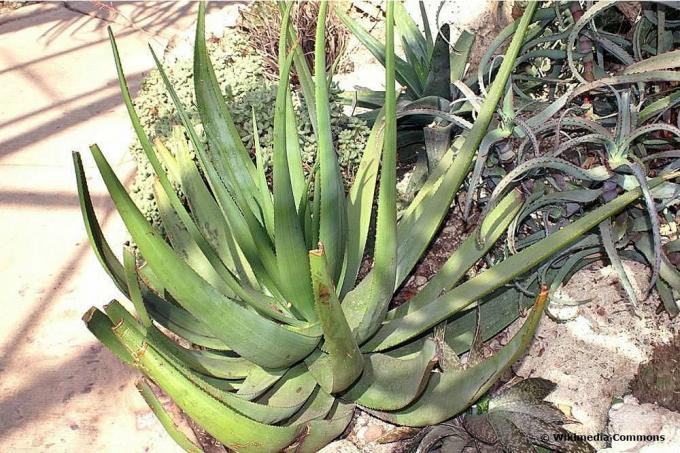
As a rule, these aloes always grow individually. There is also no trunk. The leaves are upright and slightly pointed at the end. They can be 60 to 90 centimeters long.
- branched inflorescence
- Height up to 175 cm
- The flowers are bright orange to scarlet red
- The flower has a slightly yellowish taper
A. grandidentata

The home of these aloes is in Botswana. usually they grow in groups. A tribe is not formed. The green and white spotted leaves stand together in a dense rosette. The relatively large teeth on the leaf margins are impressive.
- 90 cm high inflorescence
- branched and growing
- Flower color pale red to whitish
A. humilis

These stemless aloes are native to South Africa. They have a short stature. The narrow, very fleshy and up to 30 centimeters long leaves are arranged in a rosette. The strong green leaves are covered with white, small warts. The plants have an ornamental value.
- inflorescences up to 40 cm high
- 3 cm long flowers in racemes
- Flowering March to April
- Flower color coral red with yellow tips
A. koenenii
This type of aloe has its origin in North Africa. The trunk is usually creeping and growing. The upright leaves are very slender. In young plants they are spotted white and turn green with age.
- branched inflorescence
- Height up to 120 cm
- Flower color deep carmine
A. lineata

This variety is originally from South Africa. At a young age it grows close to the ground. A trunk only forms with increasing age. The plant can reach a height of 2 meters. The leaves are relatively thin, but very long. They are light green to yellowish in color and there are red spines on the edges.
- The stem is 75 to 100 cm long
- Salmon pink flower color
A. peglerae

- 40 cm high inflorescence
- Flower color creamy white to pale red
A. saponaria (A. maculata)

This species is also known as soap alous. The plant parts contain a gel that can be used to wash hands or laundry. The aloe species can grow individually or sometimes in dense groups.
- 40 to 100 cm high inflorescence
- Flower color varies
- from salmon pink to orange and yellow to red
The gel of the plants is used in the manufacture of cosmetic products. Consumption should be avoided.



